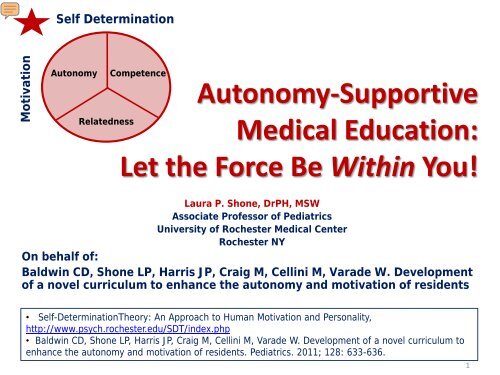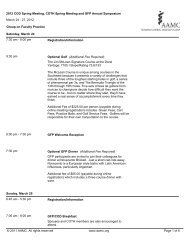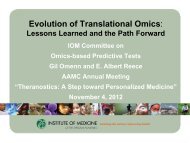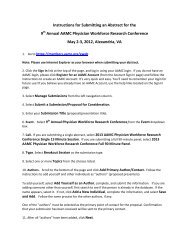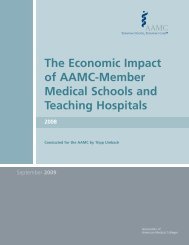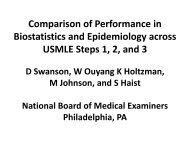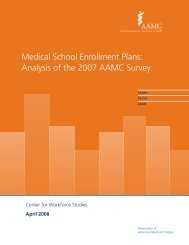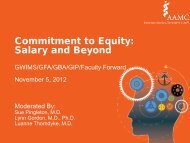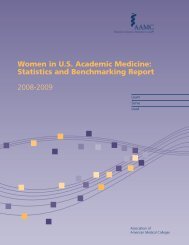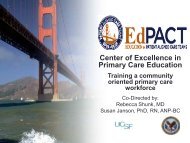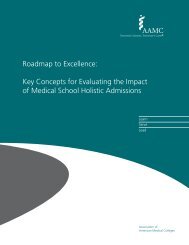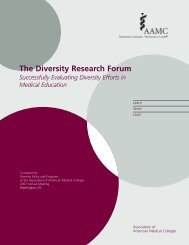Autonomy
Autonomy
Autonomy
Create successful ePaper yourself
Turn your PDF publications into a flip-book with our unique Google optimized e-Paper software.
Self Determination<br />
Motivation<br />
<strong>Autonomy</strong><br />
Relatedness<br />
Competence<br />
<strong>Autonomy</strong>-Supportive<br />
Medical Education:<br />
Let the Force Be Within You!<br />
Laura P. Shone, DrPH, MSW<br />
Associate Professor of Pediatrics<br />
University of Rochester Medical Center<br />
Rochester NY<br />
On behalf of:<br />
Baldwin CD, Shone LP, Harris JP, Craig M, Cellini M, Varade W. Development<br />
of a novel curriculum to enhance the autonomy and motivation of residents<br />
• Self-DeterminationTheory: An Approach to Human Motivation and Personality,<br />
http://www.psych.rochester.edu/SDT/index.php<br />
• Baldwin CD, Shone LP, Harris JP, Craig M, Cellini M, Varade W. Development of a novel curriculum to<br />
enhance the autonomy and motivation of residents. Pediatrics. 2011; 128: 633-636.<br />
1
Self-Determination Theory: Satisfaction<br />
of three innate psychological needs<br />
drives motivation<br />
<strong>Autonomy</strong>:<br />
‣Desire to be the<br />
source of one’s<br />
own behavior<br />
‣ Feeling of freedom<br />
to choose one’s<br />
own goals<br />
Self-<br />
Determination<br />
Competence:<br />
‣ Desire to feel<br />
effective in<br />
actions one<br />
pursues and<br />
performs<br />
‣ Perception of<br />
confidence and<br />
accomplishment<br />
Relatedness:<br />
‣ Desire to feel connected with others<br />
‣ Sense of belonging to a valued group<br />
Ryan, RM and Deci, EL. Self-Determination theory and the facilitation of intrinsic motivation, social<br />
development, and well-being. American Psychologist, 2000, 55(1): 68-78.<br />
2
Self-determination is a key factor in<br />
motivation, which fuels the drive to learn<br />
Motivation = human energy directed toward a goal:<br />
It is autonomous when the goal is chosen because<br />
of its intrinsic value to the individual<br />
It is controlled if the goal is dictated by others<br />
Many forces influence a student’s motivation to learn:<br />
‣Personal interests and needs<br />
‣Influence of peers<br />
‣Evaluation: grades, exams<br />
‣System mandates: schedules, regulations,<br />
curriculum requirements, documentation<br />
In medical education, autonomous motivation<br />
is constantly challenged by external controls<br />
Internal<br />
locus of<br />
control<br />
External<br />
locus of<br />
control<br />
3
Findings of motivation research show<br />
these educational associations:<br />
• Skill in rote<br />
memorization and<br />
algorithmic performance<br />
• Behavior dependent on<br />
contingencies<br />
• Erosion of intrinsic<br />
motivation for future<br />
learning<br />
Autonomous motivation<br />
creates learners with:<br />
• Higher academic achievement<br />
• Higher perceived competence<br />
• Preference for optimal challenge<br />
• Higher self-worth<br />
• Stronger sense of community<br />
• More creativity<br />
Our task: To stimulate intrinsic motivation in<br />
learners, even though we teach in a highly<br />
controlling environment!<br />
Ten Cate, Kusurkar, Williams. How self-determination theory can assist our understanding of the teaching<br />
4<br />
and learning processes in medical education. AMEE guide No. 59. Med Teach. 2011;33:961-73.
Motivation<br />
Self Determination<br />
<strong>Autonomy</strong> Competence<br />
Relatedness<br />
How can you practice<br />
autonomy-supportive<br />
education?<br />
• Give learners choices<br />
• Acknowledge their perspectives<br />
• Encourage their acceptance of personal responsibility<br />
• Provide them with constructive feedback<br />
• Evaluate them using individualized assessment<br />
• Grant them full responsibility for specific tasks once they<br />
have demonstrated competence<br />
Self-determined learners thrive when they feel<br />
autonomous, competent and part of a community<br />
Kusurkar, Croisel, ten Cate. Twelve tips to simulate intrinsic motivation in students through autonomysupportive<br />
classroom teaching derived from Self-Determination Theory. Med Teach. 2011; 33:978-982.<br />
5
And what about all those rules and mandates?<br />
• In SDT, self-regulation (like motivation) can be controlled, or<br />
autonomous, or somewhere in between<br />
• When learners are coerced, they self-regulate because of fear or shame<br />
• When learners are helped to see the value of rules in a personally<br />
meaningful context, they learn to self-regulate around external<br />
controls that they have “integrated” into their value system<br />
• Integrated self-regulation allows autonomous individuals to maintain<br />
motivation, even in a controlling environment—IF the rules are in fact<br />
meaningful to them! Learners need:<br />
– <strong>Autonomy</strong> support<br />
– Understanding that rules can have personal meaning<br />
Self-regulation goes hand in hand with autonomy in<br />
the world of self-determined physicians who are<br />
independent, responsible, inquisitive and fulfilled<br />
6
Positive Factors<br />
PERSONAL:<br />
•Drive to excel<br />
•Reflection<br />
•Self assessment<br />
•Goal setting &<br />
tracking<br />
•Work/life balance<br />
Inherent or<br />
Learned SD<br />
traits<br />
ENVIRONMENTAL:<br />
•Healthy work climate<br />
•Peer/social support<br />
•Manageable schedule<br />
<strong>Autonomy</strong><br />
Relatedness<br />
Competence<br />
Educationally<br />
Enhanced<br />
Self-<br />
Determination<br />
EDUCATIONAL:<br />
•Practice of adult learning<br />
•Learning from preceptors, peers<br />
& patients<br />
•Didactics & self-directed learning<br />
•Learner input into learning<br />
agenda<br />
Self determined<br />
physician:<br />
independent<br />
responsible<br />
inquisitive<br />
fulfilled<br />
Negative Factors<br />
PERSONAL BARRIERS:<br />
•Conflicting priorities<br />
•Weak professional<br />
commitment<br />
•Poor time management<br />
•Lack of social support<br />
•Sleep loss & burnout<br />
SYSTEM BARRIERS:<br />
•Abusive hours<br />
•Paperwork burden<br />
•Inflexible regulations<br />
•Patient safety/litigation<br />
protections<br />
•Lack of continuity in<br />
patient care<br />
EDUCATIONAL BARRIERS:<br />
•Passive learning<br />
•Limited freedom of<br />
choice<br />
•Harsh evaluation; lack<br />
of constructive feedback<br />
•Insufficient time for<br />
reflection & learning<br />
7


